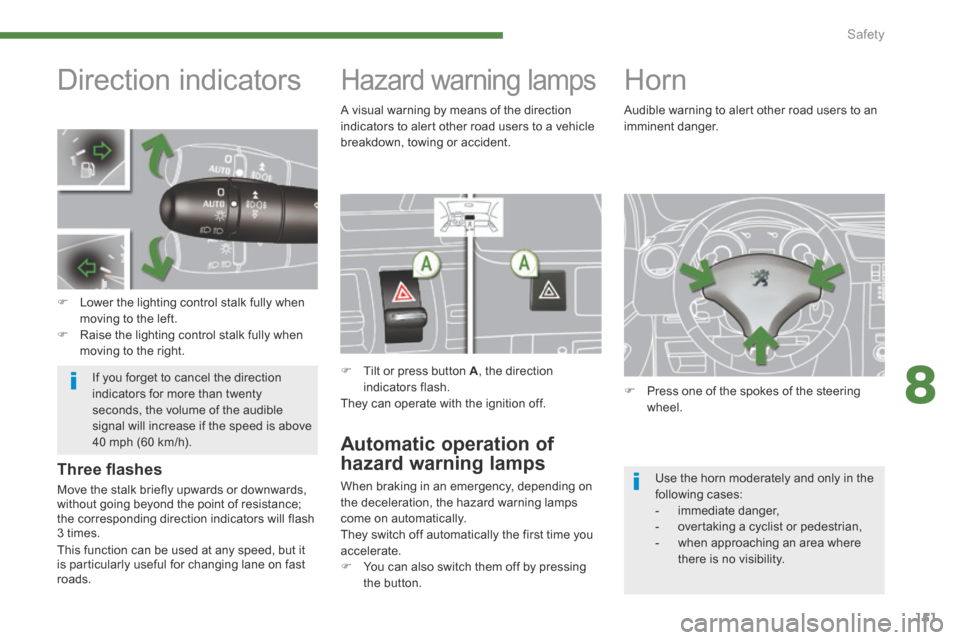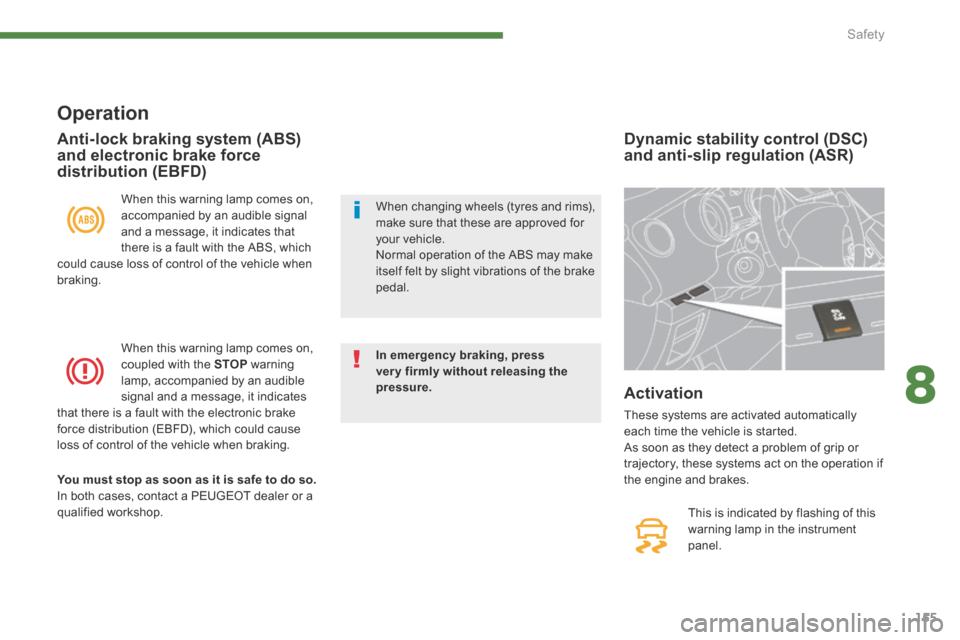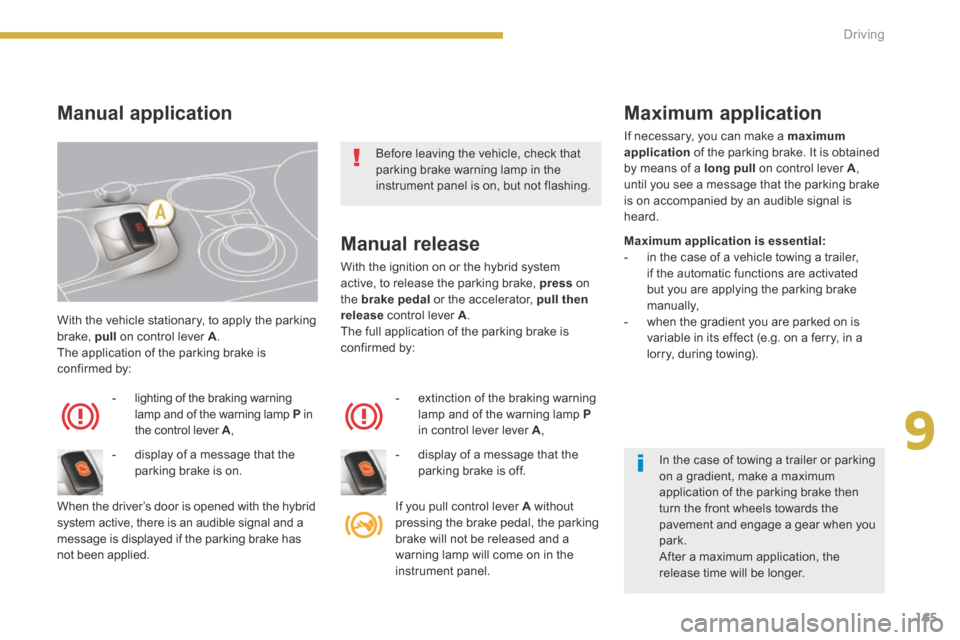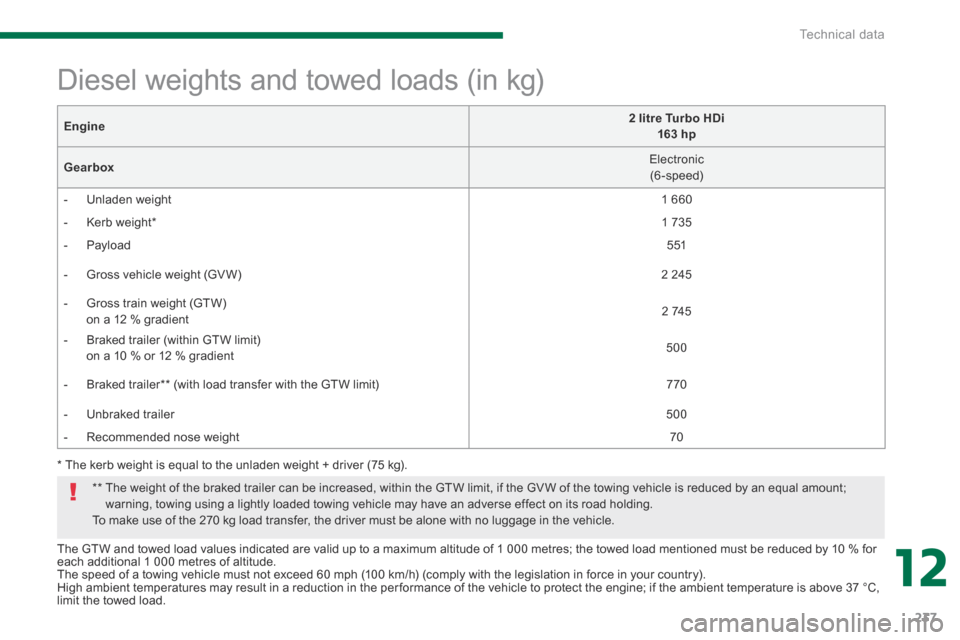2014 Peugeot 3008 Hybrid 4 warning light
[x] Cancel search: warning lightPage 116 of 378

Visibility
114
Automatic illumination of
headlamps
When a low level of ambient light is detected by a sunshine sensor, the number plate lamps, sidelamps and dipped beam headlamps are switched on automatically, without any action on the part of the driver. They can also come on if rain is detected, at the same time as automatic operation of the windscreen wipers. As soon as the brightness returns to a sufficient level or after the windscreen wipers are switched off, the lamps are switched off automatically.
Activation
Turn the ring to the "AUTO" position. The activation of the function is accompanied by the display of a message in the screen.
Deactivation
Turn the ring to another position. Deactivation of the function is accompanied by the display of a message in the screen.
When the automatic illumination of headlamps function is activated, under low ambient light the dipped beams headlamps come on automatically when the ignition is switched off.
Operating fault
In the event of a malfunction of the sunshine sensor, the lighting comes on, this warning lamp is displayed in the instrument panel and/or a message appears in the screen, accompanied by an audible signal. Contact a PEUGEOT dealer or a qualified workshop.
Automatic "guide-me-
home" lighting
Programming
Activation or deactivation, as well as the duration of the guide-me-home lighting, is set in the vehicle configuration menu.
In fog or snow, the sunshine sensor may detect sufficient light. In this
case, the lighting will not come on automatically. Do not cover the sunshine sensor, coupled with the rain sensor and located in the centre of the windscreen behind the rear view mirror; the associated functions would no longer be controlled.
Page 153 of 378

8
Safety151
Direction indicators
Lower the lighting control stalk fully when moving to the left. Raise the lighting control stalk fully when moving to the right.
Hazard warning lamps
Tilt or press button A , the direction indicators flash. They can operate with the ignition off.
Automatic operation of
hazard warning lamps
When braking in an emergency, depending on the deceleration, the hazard warning lamps come on automatically.
They switch off automatically the first time you accelerate. You can also switch them off by pressing the button.
Horn
Press one of the spokes of the steering wheel.
Audible warning to alert other road users to an imminent danger.
Three fl ashes
Move the stalk briefly upwards or downwards, without going beyond the point of resistance; the corresponding direction indicators will flash 3 times.
If you forget to cancel the direction indicators for more than twenty seconds, the volume of the audible signal will increase if the speed is above
40 mph (60 km/h).
Use the horn moderately and only in the following cases: - immediate danger, - overtaking a cyclist or pedestrian, - when approaching an area where there is no visibility.
A visual warning by means of the direction indicators to alert other road users to a vehicle breakdown, towing or accident.
This function can be used at any speed, but it is particularly useful for changing lane on fast roads.
Page 157 of 378

8
Safety155
Dynamic stability control (DSC) and anti-slip regulation (ASR)
This is indicated by flashing of this warning lamp in the instrument panel.
Activation
These systems are activated automatically each time the vehicle is started. As soon as they detect a problem of grip or trajectory, these systems act on the operation if the engine and brakes.
Operation
When this warning lamp comes on, accompanied by an audible signal and a message, it indicates that there is a fault with the ABS, which could cause loss of control of the vehicle when braking.
When this warning lamp comes on, coupled with the STOP warning lamp, accompanied by an audible signal and a message, it indicates that there is a fault with the electronic brake force distribution (EBFD), which could cause loss of control of the vehicle when braking.
You must stop as soon as it is safe to do so. In both cases, contact a PEUGEOT dealer or a qualified workshop.
Anti-lock braking system (ABS) and electronic brake force distribution (EBFD)
In emergency braking, press very firmly without releasing the pressure.
When changing wheels (tyres and rims), make sure that these are approved for your vehicle. Normal operation of the ABS may make itself felt by slight vibrations of the brake pedal.
Page 161 of 378

8
Safety159
In the event of an accident, the high voltage is disconnected automatically.
The driver must ensure that passengers use the seat belts correctly and that they are all restrained securely before setting off. Wherever you are seated in the vehicle, always fasten your seat belt, even for short journeys. Do not interchange the seat belt buckles as they will not fulfil their role fully. The seat belts are fitted with an inertia reel permitting automatic adjustment of the length of the strap to your size. The seat belt is stowed automatically when not in use. Before and after use, ensure that the seat belt is reeled in correctly. The lower part of the strap must be positioned as low as possible on the pelvis. The upper part must be positioned in the hollow of the shoulder. The inertia reels are fitted with an automatic locking device which comes into operation in the event of a collision, emergency braking or if the vehicle rolls over. You can release the device by pulling firmly on the strap and releasing it so that it reels in slightly.
In order to be effective, a seat belt must: - be tightened as close to the body as possible, - be pulled in front of you with a smooth movement, checking that it does not twist, - be used to restrain only one person, - not bear any trace of cuts or fraying, - not be converted or modified to avoid affecting its performance.
In the event of an impact
Depending on the nature and seriousness of the impact , the pretensioning device may be deployed before and independently of the airbags. Deployment of the pretensioners is accompanied by a slight discharge of harmless smoke and a noise, due to the activation of the pyrotechnic cartridge incorporated in the system. In all cases, the airbag warning lamp comes on. Following an impact, have the seat belts system checked, and if necessary replaced, by a PEUGEOT dealer or a qualified workshop.
Recommendations for children
Use a suitable child seat if the passenger is less than 12 years old or shorter than one and a half metres. Never use the same seat belt to secure more than one person. Never allow a child to travel on your lap.
In accordance with current safety regulations, for all repairs on your vehicle, go to a qualified workshop with the skills and equipment needed, which a PEUGEOT dealer is able to provide. Have your seat belts checked regularly by a PEUGEOT dealer or a qualified workshop, particularly if the straps show signs of damage.
Clean the seat belt straps with soapy water or a textile cleaning product, sold by PEUGEOT dealers. After folding or moving a seat or rear bench seat, ensure that the seat belt is positioned and reeled in correctly.
Page 167 of 378

9
165
Driving
With the vehicle stationary, to apply the parking brake, pull on control lever A . The application of the parking brake is confirmed by:
- lighting of the braking warning lamp and of the warning lamp P in
the control lever A ,
When the driver’s door is opened with the hybrid system active, there is an audible signal and a
message is displayed if the parking brake has not been applied.
Manual release
With the ignition on or the hybrid system active, to release the parking brake, press on the brake pedal or the accelerator, pull then release control lever A . The full application of the parking brake is confirmed by:
- extinction of the braking warning lamp and of the warning lamp P
in control lever lever A ,
If you pull control lever A If you pull control lever A If you pull control lever without pressing the brake pedal, the parking
brake will not be released and a warning lamp will come on in the instrument panel.
Manual application Maximum application
If necessary, you can make a maximum application of the parking brake. It is obtained by means of a long pull on control lever A , until you see a message that the parking brake is on accompanied by an audible signal is heard.
Maximum application is essential: - in the case of a vehicle towing a trailer, if the automatic functions are activated but you are applying the parking brake manually, - when the gradient you are parked on is variable in its effect (e.g. on a ferry, in a lorry, during towing).
- display of a message that the parking brake is on. - display of a message that the parking brake is off.
Before leaving the vehicle, check that parking brake warning lamp in the instrument panel is on, but not flashing.
In the case of towing a trailer or parking on a gradient, make a maximum application of the parking brake then turn the front wheels towards the pavement and engage a gear when you park. After a maximum application, the release time will be longer.
Page 232 of 378

Practical information
230
Cooling
Towing a trailer on a slope increases the temperature of the coolant. As the fan is electrically controlled, its cooling capacity is not dependent on the engine speed. To lower the engine speed, reduce your speed. The maximum towed load on a long incline depends on the gradient and the ambient temperature. In all cases, keep a check on the coolant temperature.
Side wind
Take into account the increased sensitivity to side wind.
Ty r e s
Check the tyre pressures of the towing vehicle and of the trailer, observing the recommended pressures.
Braking
Towing a trailer increases the braking distance.
If the warning lamp and the STOP warning lamp come on, stop the vehicle and switch off the engine as soon as possible.
Lighting
Check the electrical lighting and signalling on the trailer.
The rear parking sensors will be deactivated automatically if a genuine PEUGEOT towbar is used.
Page 239 of 378

12
Technical data237
The GTW and towed load values indicated are valid up to a maximum altitude of 1 000 metres; the towed load mentioned must be reduced by 10 % for each additional 1 000 metres of altitude. The speed of a towing vehicle must not exceed 60 mph (100 km/h) (comply with the legislation in force in your country). High ambient temperatures may result in a reduction in the per formance of the vehicle to protect the engine; if the ambient temperature is above 37 °C, limit the towed load.
Diesel weights and towed loads (in kg)
* The kerb weight is equal to the unladen weight + driver (75 kg).
Engine2 litre Turbo HDi 163 hp
Gearbox Electronic (6-speed)
- Unladen weight 1 6 6 0
- Kerb weight * 1 7 3 5
- Payload 5 5 1
- Gross vehicle weight (GV W) 2 2 4 5
- Gross train weight (GTW) on a 12 % gradient 2 7 4 5
- Braked trailer (within GTW limit) on a 10 % or 12 % gradient 5 0 0
- Braked trailer ** (with load transfer with the GTW limit) 7 7 0
- Unbraked trailer 5 0 0
- Recommended nose weight 7 0
** The weight of the braked trailer can be increased, within the GTW limit, if the GV W of the towing vehicle is reduced by an equal amount; warning, towing using a lightly loaded towing vehicle may have an adverse effect on its road holding. To make use of the 270 kg load transfer, the driver must be alone with no luggage in the vehicle.
Page 366 of 378

Alphabetical index
364
Filling with fuel .......................................105 -107Fitting a wheel ...............................................206Fitting roof bars .............................................231Fittings, boot .................................................132Flashing indicators ........................................151Flat bed lorry or trailer ............................Flat bed lorry or trailer ............................Flat bed lorry or trailer47, 228Foglamps, front .............................110, 209, 211Foglamps, rear ..............................Foglamps, rear ..............................Foglamps, rear110, 212, 213Folding the rear seats .....................................85Folding/unfolding the door mirrors .................88Front seats ..........................................80, 81, 84
Gearbox, electronic ......................................179Gear lever, electronic ....................................179Glove box ......................................................125G . P. S . ...................................................256, 295Grab handle on console ..................................................124Grab handles ................................................124Guidance ..............................................256, 295Guide-me-home ....................................113 , 114
Halogen headlamps ..............................209, 210Hands-free kit ...............................273, 312, 353Hazard warning lamps ..................................151Headlamp adjustment ...................................115Headlamp wash ............................................118Headlamp wash reservoir .............................Headlamp wash reservoir .............................Headlamp wash reservoir19 4Head restraints, front ......................................82
Identification plates .......................................239Indicator lamps, status ..............................50-59Indicators, direction ......................................151Inflating accessories (using the kit) ..............202Inflating tyres ..........................................40, 239Inputs for audio system ................125, 126, 272, 329, 350, 352Instrument panel lighting ................................64Instrument panels .....................................48, 49Instrument panel screen .................................49Interior fittings ...............................................124Interior mood lighting ....................................12 2ISOFIX ...................................................146 -148ISOFIX child seats ........................................147ISOFIX mountings.........................................146
Fuel........................................................105, 10 6Fuel consumption ......................................40, 42Fuel filler cap .................................................107Fuel filler flap .................................................107Fuel gauge ..............................................48, 105Fuel tank................................................105, 107Fusebox, dashboard .....................................215Fuses .............................................................214
F
E
G
H
I
Eco-driving .....................................................40Economy mode .............................................225Eco off .............................................................Eco off .............................................................Eco off36Electric window controls .................................98Electronic engine immobiliser.........................93Electronic gearbox ................................179, 196Electronic stability control (ESC) ..................15 4Emergency call ......................................241-243Emergency starting .......................................222Emergency warning lamps ...........................151Energy economy mode .................................225Engine compartment ..............................45, 191Engine compartment fusebox .......................218Engine, Diesel ...............106, 190, 191, 236, 237Engine oil level indicator .........................Engine oil level indicator .........................Engine oil level indicator63, 192Engines ................................................235, 236Environment .....................40, 95, 152, 194, 223Equipment settings .............................49, 65, 68ESC/ASR .......................................................15 4
Head restraints, rear ................................................................rear ................................................................rear85Head-up display ............................171, 173, 176Heated seats ...................................................83Heating ............................................................74Height and reach adjustment, steering wheel ..............................................87High voltage .....................43, 44, 159, 189, 223High voltage cables ........................................44Hill start assist ...............................................168History .......................................................42, 72Hooks ............................................................13 5Horn...............................................................151Hybrid flow ............................................4, 24, 33Hybrid selector ................................................Hybrid selector ................................................Hybrid selector29Hybrid system ............................4- 6, 24- 47, 221